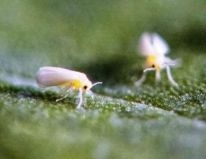

White fly
Photo: BASF
Scientists from BASF Crop Protection and the University of Göttingen in Germany have found a new insecticide target protein. The discovery marks the first identification of vanilloid receptors, the TRPV ion channels, as insecticide targets. The results were published in the scientific journal Neuron. They could help to better manage insecticide resistance and have implications for research and insecticide usage.
In their study, the scientists focused on the mode of action of the insecticides pymetrozine and pyrifluquinanzon. They identified a novel TRPV ion channel complex as the target protein of the two chemicals.
In insects, two TRPV channels exist, which occur together in certain stretch receptors that are present in joints, for example in the antennae and legs. By sensing mechanical stimuli, these stretch receptors provide insects with their senses of balance, hearing and coordination.
The two insecticides only act selectively on these stretch receptors because they activate an ion channel complex formed by the two TRPV channels. By activating this TRPV channel complex, the insecticides overstimulate the stretch receptors, disturbing insect locomotion and feeding. Substances with this mode of action are effective against many plant-sucking pests, particularly whiteflies and aphids.
By knowing the exact target of pymetrozine and pyrifluquinanzon, the industry can now provide better advice on spray programs to farmers. „For instance, we would not want to treat fields with these two substances one after the other. The more you attack one particluar site, the faster insects will become resistant. The findings help us to use insecticides more wisely and more sustainably,“ says Dr. Vincent Salgado, biologist at BASF Crop Protection.
„The fact that the two insecticides target a TRPV channel complex is particularly interesting,“ says the Göttingen neuroscientist Prof. Dr. Martin Göpfert. „For a long time we thought that the two insect TRPVs might form a complex in those stretch receptors, but only the insecticides allowed us to show that this is what they do.“
The study thus encompasses exciting biology: It identifies a novel ion channel complex that plays a key role in the detection of mechanical stimuli. Furthermore, the methods employed by the study can be applied to other insecticides, and they may help in the identification of new insecticides with similar modes of action.
Original publication: Alexandre Nesterov et al. TRP Channels in Insect Stretch Receptors as Insecticide Targets. Neuron 2015. Doi: 10.1016/j.neuron.2015.04.001.
Contact:
Prof. Dr. Martin Göpfert
University of Göttingen – Department of Cellular Neurobiology
Julia-Lermontowa-Weg 3, 37077 Göttingen
Phone +49 551 39-177955
Email: mgoepfe@gwdg.de
Web: www.cellneuro.uni-goettingen.de/index.php
Friederike Wurth
BASF SE Crop protection
Phone +49 621 60-28182
Email: friedrike.wurth@basf.com












